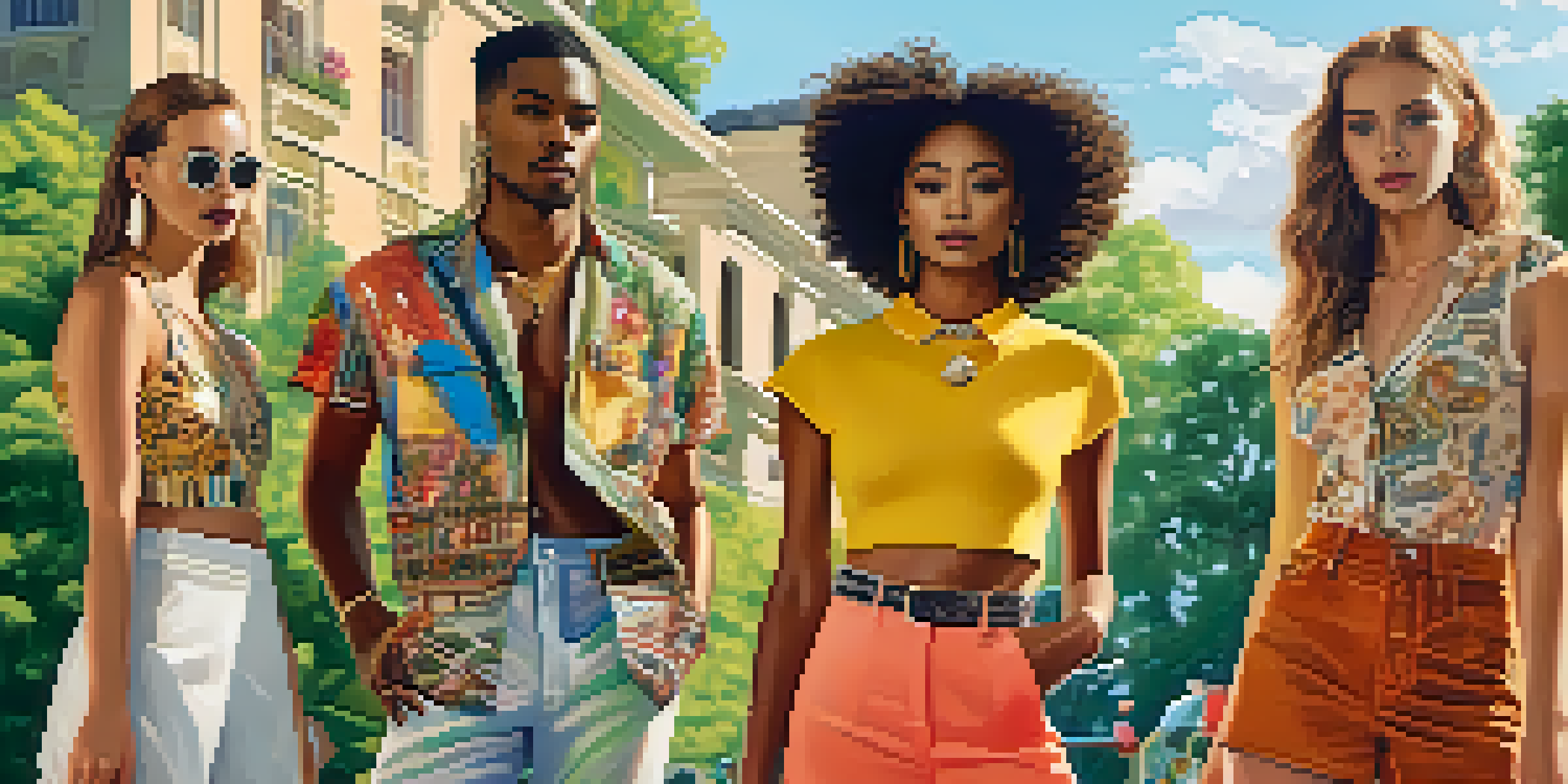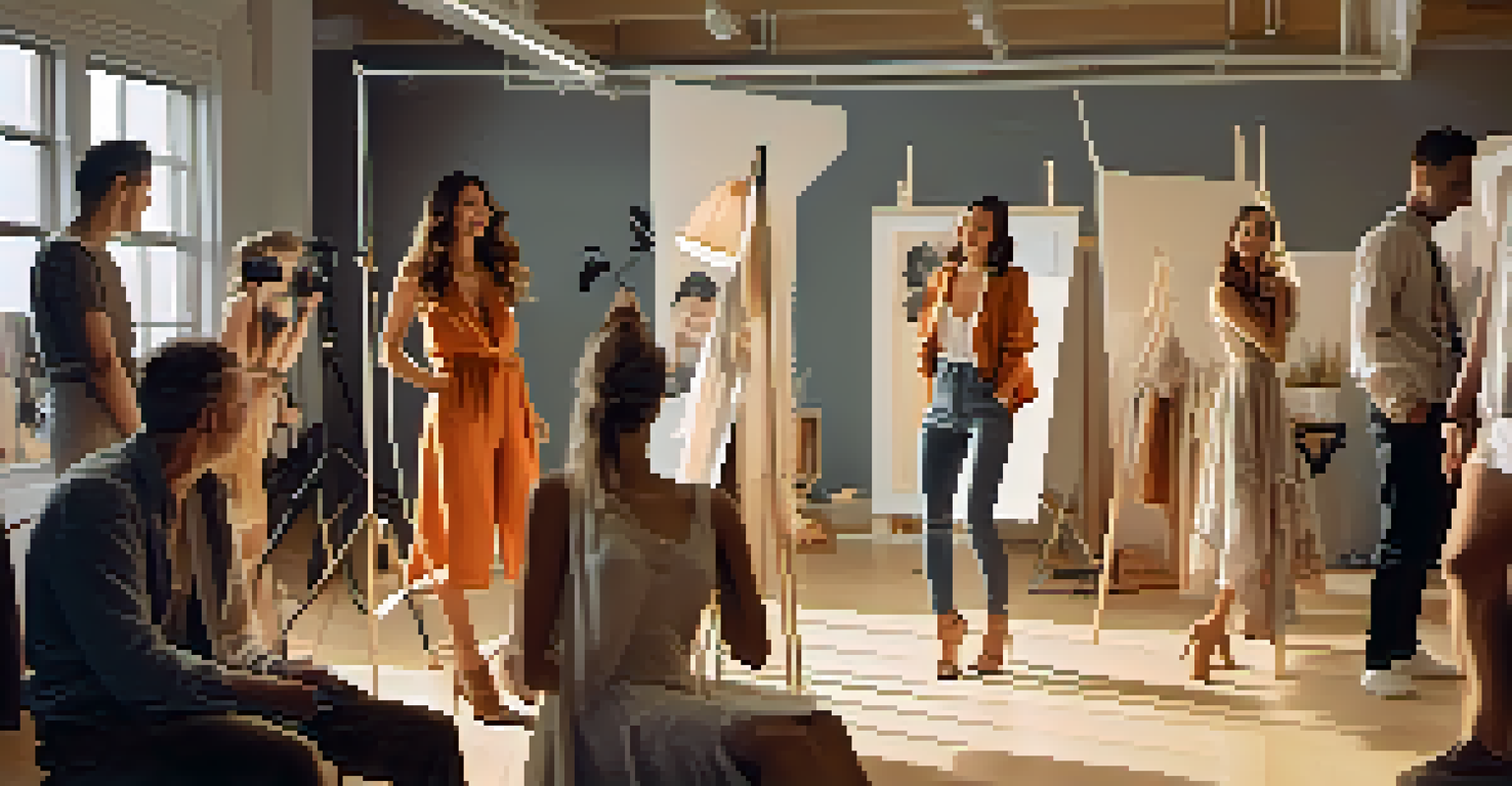The Impact of Social Media on Fashion Photography Trends

The Rise of Social Media in Fashion Photography
Social media has transformed the landscape of fashion photography, making it more accessible than ever. Platforms like Instagram and Pinterest allow photographers to showcase their work instantly, reaching audiences worldwide. This shift has democratized fashion photography, enabling emerging talent to gain recognition alongside established professionals.
Fashion is the armor to survive the reality of everyday life.
With just a smartphone, anyone can capture and share their fashion moments, blurring the lines between amateur and professional photography. As a result, the emphasis on polished, high-budget shoots has diminished, giving way to a more spontaneous and relatable approach. This has led to a diverse array of styles and perspectives that were previously underrepresented.
Additionally, social media encourages a sense of community among photographers, models, and fashion enthusiasts. Hashtags, collaborations, and user-generated content foster connections that help to amplify individual voices, shaping a new narrative in fashion photography that reflects real-life experiences.
Changing Aesthetics: Authenticity Over Perfection
In the age of social media, there’s a noticeable shift towards authenticity in fashion photography. Audiences are becoming more drawn to images that feel genuine rather than overly staged or edited. This trend has prompted photographers to embrace raw, unfiltered moments that capture real emotions and stories.

For example, consider the popularity of behind-the-scenes shots and candid moments that showcase the process of creating fashion images. These glimpses into the less polished side of fashion not only humanize the industry but also resonate with viewers on a personal level. They invite audiences into the narrative, making them feel like part of the journey.
Social Media Empowers Fashion Photographers
Platforms like Instagram and Pinterest have democratized fashion photography, allowing emerging talents to gain recognition alongside established professionals.
As a result, brands and photographers are increasingly prioritizing storytelling over traditional aesthetics. By focusing on narratives that highlight individuality and personal style, they're able to create a deeper connection with their audience, ultimately transforming the way fashion is visually represented.
Influencer Culture's Impact on Fashion Photography
Influencer culture has become a driving force in shaping fashion photography trends. As social media influencers gain massive followings, they often set the tone for what’s considered stylish and trendy. This power to influence has led photographers to adapt their work to align with the aesthetics favored by these online personalities.
In a world where you can be anything, be kind.
Moreover, influencers frequently collaborate with brands and photographers, creating a symbiotic relationship that benefits both parties. These partnerships not only amplify the reach of fashion photography but also introduce new styles and ideas that challenge conventional norms. The result is a dynamic landscape where trends can emerge and evolve rapidly.
In this environment, photographers are constantly seeking innovative ways to capture and present fashion to stay relevant. This has led to a surge in creative experimentation, with unique concepts and visual styles becoming more commonplace. The influence of social media has, therefore, encouraged a more diverse and imaginative approach to fashion photography.
The Role of User-Generated Content in Fashion Trends
User-generated content (UGC) has become a significant aspect of fashion photography, driven by social media platforms. Brands now encourage their customers to share photos of themselves wearing their products, creating a sense of community and engagement. This not only enhances brand visibility but also showcases real people embracing fashion in their own unique ways.
The impact of UGC on fashion trends is profound, as it reflects diverse body types, styles, and cultural backgrounds. This inclusivity challenges traditional fashion representations and promotes a more relatable vision of beauty. Audiences are more likely to engage with brands that showcase real-life scenarios over aspirational imagery.
Authenticity Replaces Perfection
Audiences now favor genuine and raw moments in fashion photography, shifting the focus from overly staged images to real emotions and stories.
Additionally, UGC serves as a valuable source of inspiration for professional photographers. By observing how consumers interact with fashion, photographers can identify emerging trends and adapt their work accordingly. This feedback loop creates a more responsive fashion photography landscape, where creativity thrives.
The Influence of TikTok on Fashion Photography Styles
TikTok has quickly become a powerhouse in influencing fashion photography trends, especially among younger audiences. The platform's short-form video format encourages creative storytelling and innovative visual techniques that resonate with users. As a result, photographers are inspired to incorporate dynamic elements into their work, such as motion and quick transitions.
Fashion challenges and trends that go viral on TikTok often inspire photographers to capture styles in unique ways. For instance, the 'outfit of the day' (OOTD) videos emphasize personal style, prompting photographers to experiment with new angles and storytelling methods. This shift has led to a more playful and experimental approach to fashion photography.
Moreover, TikTok's emphasis on trends that change rapidly means photographers must stay agile and responsive. This fosters a culture of constant innovation, where photographers are encouraged to push creative boundaries and explore various styles. The result is a fresh and ever-evolving fashion photography landscape that reflects current cultural moments.
How Hashtags Shape Fashion Photography Visibility
Hashtags play a crucial role in enhancing the visibility of fashion photography on social media. By using relevant hashtags, photographers can ensure their work reaches a broader audience beyond their immediate followers. This practice has transformed how fashion images are discovered and shared, creating a democratic space for creativity.
For example, trending hashtags like #OOTD or #FashionInspo allow photographers to tap into existing conversations and connect with like-minded individuals. This not only increases exposure but also fosters networking opportunities within the industry. The more a photographer engages with these communities, the more recognition they can gain.
TikTok Drives Innovative Trends
The rise of TikTok has led photographers to adopt dynamic storytelling techniques, pushing creative boundaries and reflecting current cultural moments.
Additionally, brands often track hashtag performance to identify emerging trends and talents. This insight can lead to collaborations that further amplify a photographer's reach. In this way, hashtags not only enhance visibility but also serve as a vital tool for building a professional network in the fast-paced world of fashion photography.
Future Trends in Fashion Photography Driven by Social Media
Looking ahead, the future of fashion photography will likely be shaped significantly by social media trends. As technology evolves, we can expect more immersive experiences, such as augmented reality (AR) and virtual reality (VR), to influence how fashion is photographed and consumed. These advancements could create entirely new avenues for storytelling and visual representation.
Moreover, the rise of platforms like TikTok suggests that dynamic, fast-paced content will continue to dominate. Photographers may need to adopt a more fluid approach, focusing on quick, engaging visuals that capture attention instantly. This shift could lead to a new standard in fashion photography that prioritizes immediacy and creativity.

Finally, as the demand for inclusivity and diversity grows, fashion photography will likely evolve to reflect these values more prominently. This means embracing various body types, styles, and cultures, resulting in a richer tapestry of fashion imagery that resonates with a broader audience. The future of fashion photography is bright, vibrant, and full of potential.